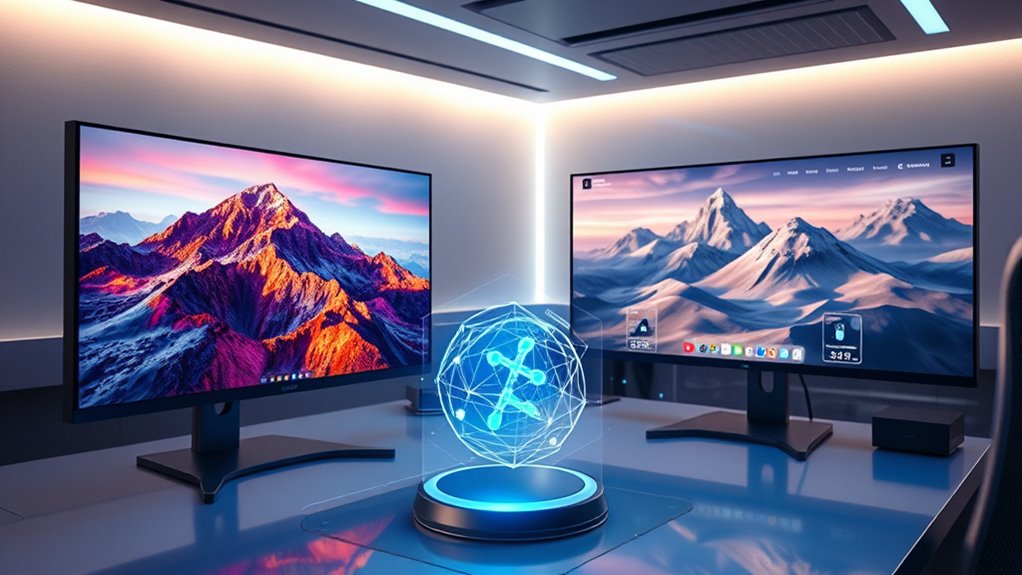AI enhances 3D video rendering by automating workflows, optimizing pipelines for quicker iterations, and improving visual quality through machine learning. It reduces rendering times while maintaining high standards, allowing you to focus on creative innovation. Real-time optimization means you can visualize changes instantly, while predictive modeling accurately forecasts resource needs, minimizing consumption. With AI's ongoing advancements, you'll discover how these innovations are reshaping the future of 3D rendering in exciting ways.
The Role of AI in Accelerating Rendering Processes
As you explore the world of 3D video rendering, you'll find that AI plays an essential role in accelerating rendering processes. By integrating automated workflows, AI streamlines tasks that would otherwise consume valuable time and resources. This technology helps you optimize rendering pipelines, enabling quicker iterations and enhanced productivity. Predictive modeling further enhances this efficiency, allowing you to anticipate rendering demands based on historical data. By leveraging AI algorithms, you can greatly reduce rendering times while maintaining quality. This not only frees up creative resources but also empowers you to focus on innovation. Ultimately, AI's integration in rendering processes transforms how you approach projects, making it possible to achieve more in less time while retaining artistic freedom.
Enhancing Visual Quality With Machine Learning
With accelerated rendering processes in place, the focus shifts to enhancing visual quality, where machine learning (ML) plays a pivotal role. By leveraging ML algorithms, you can achieve significant image enhancement, improving clarity and detail in rendered visuals. Techniques such as neural networks analyze existing textures to perform advanced texture synthesis, allowing for lifelike surfaces and dynamic environmental effects. These methods not only refine the visual output but also reduce artifacts common in traditional rendering methods. You can harness these capabilities to create immersive experiences that resonate with audiences. Ultimately, the integration of machine learning in visual quality enhancement empowers artists and developers to push creative boundaries while maintaining high standards in their 3D video projects.
Real-time Rendering and AI Optimization
While the demand for high-quality visuals continues to rise, real-time rendering has become increasingly critical in 3D video production. AI plays a pivotal role in achieving this by enabling real-time optimization, which enhances rendering efficiency. By leveraging deep learning algorithms, AI can predict and adapt to dynamic changes in scenes, considerably reducing latency. This allows artists and developers to visualize their work instantly, fostering creativity without compromise. In addition, AI techniques streamline the rendering pipeline, enabling complex calculations to be processed more effectively. As you embrace these advancements, you'll find that real-time rendering not only elevates the visual experience but also empowers your creative freedom, allowing you to push the boundaries of what's possible in 3D video rendering.
Reducing Resource Consumption Through AI Techniques
Although high-quality 3D rendering often demands significant computational resources, AI techniques can substantially mitigate this consumption. By employing machine learning algorithms, you can enhance resource allocation, allowing systems to prioritize essential tasks and minimize waste. These algorithms analyze rendering patterns and predict resource needs, optimizing computational efficiency without sacrificing quality. For instance, neural networks can intelligently downscale textures or adjust lighting dynamically, ensuring only necessary computations are performed. This targeted approach not only reduces energy consumption but also shortens rendering times. As you leverage AI to streamline processes, you free up hardware capabilities for other tasks, ultimately fostering a more sustainable, efficient 3D rendering environment that aligns with your creative aspirations.
Future Trends in AI and 3D Video Rendering
As resource consumption decreases due to AI techniques, the future of 3D video rendering is poised for significant evolution. You'll see AI advancements driving 3D innovations that enhance visual fidelity and streamline workflows. Predictive modeling will enable more accurate simulations, allowing creators to visualize complex scenes with minimal effort. Rendering automation will revolutionize production timelines, freeing artists to focus on creative collaboration rather than tedious technical tasks. Additionally, these advancements will facilitate immersive experiences, as AI tailors content to user preferences, creating personalized narratives. As you embrace these trends, your potential for creativity expands, leading to groundbreaking projects that redefine the boundaries of 3D video rendering. The future is bright, and the possibilities are virtually limitless.
Frequently Asked Questions
How Does AI Affect the Cost of 3D Video Rendering?
AI greatly enhances cost efficiency in 3D video rendering by automating complex processes, reducing manpower, and streamlining workflows. This allows you to optimize budget considerations, ultimately delivering high-quality results without exceeding financial constraints.
Can Ai-Generated Content Replace Human Artists in 3D Rendering?
You might wonder if AI-generated content can replace human artists in 3D rendering. While AI enhances efficiency, it lacks the depth of artistic expression and creative collaboration that only human artists can provide, ensuring their irreplaceability.
What Are the Limitations of AI in 3D Video Rendering?
AI in 3D video rendering faces limitations like accuracy in complex scenes and inconsistent rendering speed. You're likely to encounter challenges with nuanced textures and dynamic lighting, affecting overall realism and user experience.
Is AI Rendering Suitable for All Types of 3D Projects?
Not every 3D project is a one-size-fits-all. In game design and architectural visualization, AI rendering can shine, but it may struggle with highly detailed or artistic styles where human touch is invaluable.
How Do Different Industries Use AI in 3D Rendering?
Different industries leverage AI in 3D rendering to enhance efficiency and quality. In the gaming industry, it optimizes textures and animations, while in architectural visualization, it accelerates design iterations and creates realistic environments for client presentations.

